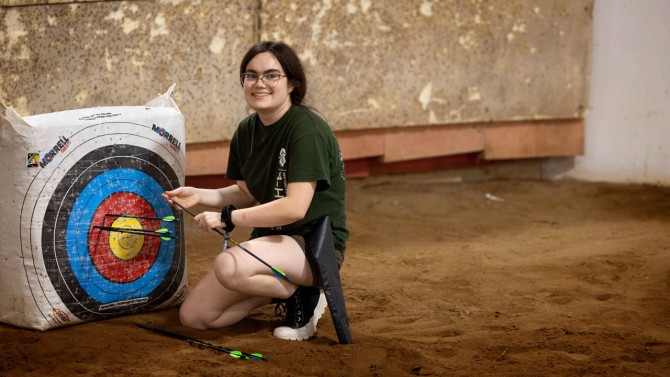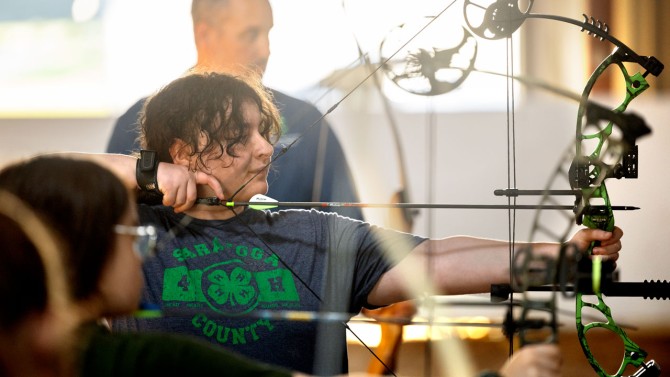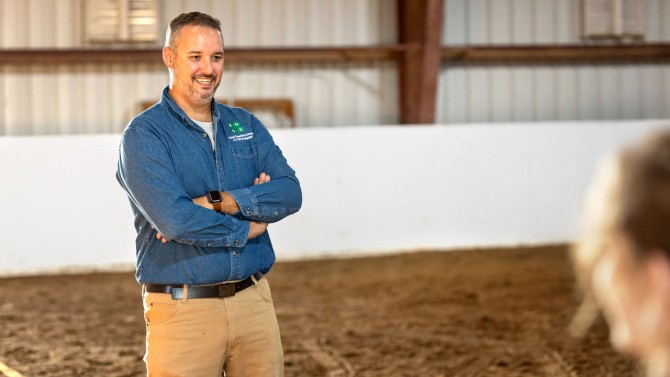The archery club in Saratoga County is part of a statewide all-gender 4-H shooting sports program offered through 38 county Cornell Cooperative Extension offices.
NYS kids find community, confidence in 4-H shooting sports
By Caitlin Hayes, Cornell Chronicle
Bella Hanson was drawn to archery before she was old enough to lift a bow.
As a 4 year-old, her favorite movie was “Brave,” and she wore a toy bow and arrow on her back, even at the dinner table.
But her mother, Patti Hanson, had little experience with archery or any other shooting sports. When she eventually registered Bella for the all-gender 4-H shooting sports program run by Cornell Cooperative Extension (CCE) of Saratoga County, she was reassured by two things: the community feel and the focus on safety.
“It wasn’t my thing, but I saw these parents running the club because their teenage daughter loved to shoot – they were like us,” Patti Hanson said. “I saw that it’s all about safety and knowing that these things are not toys and should be treated with respect.”
Patti Hanson now runs the archery club in Saratoga County with Bella, 15, as a junior instructor. The club is part of a statewide 4-H shooting sports program offered through 38 county CCE offices – with courses in archery, rifle, pistol, muzzleloading, shotgun and hunting – that aims to support the responsible use of firearms, while also creating community and fostering the positive youth development that characterizes all 4-H programming. Participation varies across the 38 counties, with some programs as small as 10 participants, ranging in age from 8 to 18, and others as large as 100. Last year, 28,000 kids interacted with the program across New York state, through clubs, camps, fairs and lessons in the schools.
“The 4-H shooting sports program is educating thousands of kids a year on appropriate understandings of, uses of and handling and securing of firearms,” said Keith Tidball, assistant director of CCE, senior extension associate with the Department of Natural Resources and the Environment and campus liaison for the 4-H shooting sports program. “There’s no other program that’s doing that in a successful way.”
In addition to safety and marksmanship, the curriculum, developed by the national 4-H organization, includes lessons in science and math, history, hunter education and conservation; for some, the program has been the first step toward careers in natural resources management. And like any sport, the program gives kids opportunities to develop discipline, leadership, sportsmanship and character.
“I fell in love with it, and my goal was just to get better and better,” said Rachel Wilbur, 19, a competitive shooter from Saratoga County. Along with two others from her club, Wilbur participated in the 2023 4-H Shooting Sports National Championships in archery in Grand Island, Nebraska, placing in the top five females overall. “Just seeing the improvements over the years, and knowing that I’m finally getting to where I want to be, continuing to chase those good shots every time – it’s the best feeling in the world.”
Focusing on focus
In Saratoga County, kids learn about more than just the mechanics of shooting. They learn about the trajectory of an arrow when it leaves the bow; the relationship between mass and velocity; the scientific method; early European settlements in New York state; and the firearms used in the Revolutionary War, to name a few. They also keep mindfulness journals and learn how to be still.
“It’s one of the only sports where the person who does best is the person who moves the least,” said Leland Bunting, 4-H resource educator with CCE of Saratoga County, who manages about 100 young people across seven clubs. “You also never play defense – it’s totally up to you, you’re competing against yourself.”
The emphasis on the mental side of the sport requires a honing of focus and concentration.
“It’s a lot of attention to detail,” Bella Hanson said. “You set up the exact same scenario every time but then change one variable to get a better shot.”
The requirement for mental focus – even more than physical strength – means it can be inclusive of kids with a range of abilities.
“You don’t have to be built like a prototypical athlete,” said John Bowe, executive director of CCE in Warren County and the state coordinator for shooting sports. “The rifle or the bow could care less if you’re tall or short, lean or stocky, or about your gender or orientation or anything like that.”
Girls and young women have been particularly active across the state, competing nationally and receiving college scholarships. Bunting said he’s also seen kids on the autism spectrum enjoy and excel in shooting sports. But far and away, he said, the most impactful aspect of shooting sports for all kids is the community they find in it.
“The important part isn’t really the shooting, it’s the social aspect,” said Bella Hanson, who is part of a group of homeschoolers who participate in shooting sports together. “Basically all of my friends I’ve met through 4-H.”
Many participants earn their certification as junior instructors, where they develop leadership skills and become peer ambassadors for firearm safety. Kids in all 4-H programs are also required to engage in public speaking.
“4-H has prepared me for so many different things, from public speaking to safety in shooting sports,” Wilbur said. “It’s prepared me for basically everything in my future.”
Keeping tradition and conservation alive
For Ashlee Zschoche, 24, who was a junior instructor in all disciplines in the shooting sports program in Steuben County and grew up hunting with her father and grandfathers, shooting sports are about tradition.
“Shooting sports were an easy way for me to connect my passion for hunting and shooting to 4-H and to keep passing on that knowledge,” she said.
Even though many participants and their families don’t hunt, an underlying goal of the program is to support and grow a skilled and responsible hunting community that is essential for natural resources management.
“Hunting and harvesting game is a part of the wildlife conservation model in North America,” Tidball said. “Take Montezuma Wildlife Refuge. If unchecked, the white-tailed deer numbers on that refuge can negatively impact the habitat for waterfowl. So one has to hunt, it has to happen.”
The excise taxes on ammunition, firearms and hunting-related equipment also fund wildlife management, so the conservation of wildlife areas depends on hunting both financially and ecologically.
“That’s the beauty and magic of 4-H shooting sports – you have the positive youth development outcomes and these conservation and wildlife values, these two converging streams of benefits that accrue for the youth, the adult volunteers and social-ecological systems at large,” Tidball said. “And if hunting is done ethically, there are social and societal benefits to participating.”
For many children and teens, 4-H’s emphasis on conservation opens paths to careers. In addition to becoming a certified 4-H shooting sports instructor who trains other instructors, Zschoche now works as a wildlife technician for the New York State Department of Environmental Conservation. One of her roles is to collect data on the deer population, to help determine how many tags should be issued during hunting season.
“It’s really come full circle for me,” Zschoche said. “But the hunting community as a whole has decreased in recent years, so I see my role as teaching but also trying to spark interest.”
Whether the end goal is hunting or not, the shooting sports program promotes mutual understanding while building confidence.
“The sky’s the limit in 4-H – whatever you want to do, you can do it,” Patti Hanson said. “The kids are going to take that with them. They’re going to grow up to be the people who, when they want to do something, they’ll go out and find it, create it.”
Media Contact
Get Cornell news delivered right to your inbox.
Subscribe




